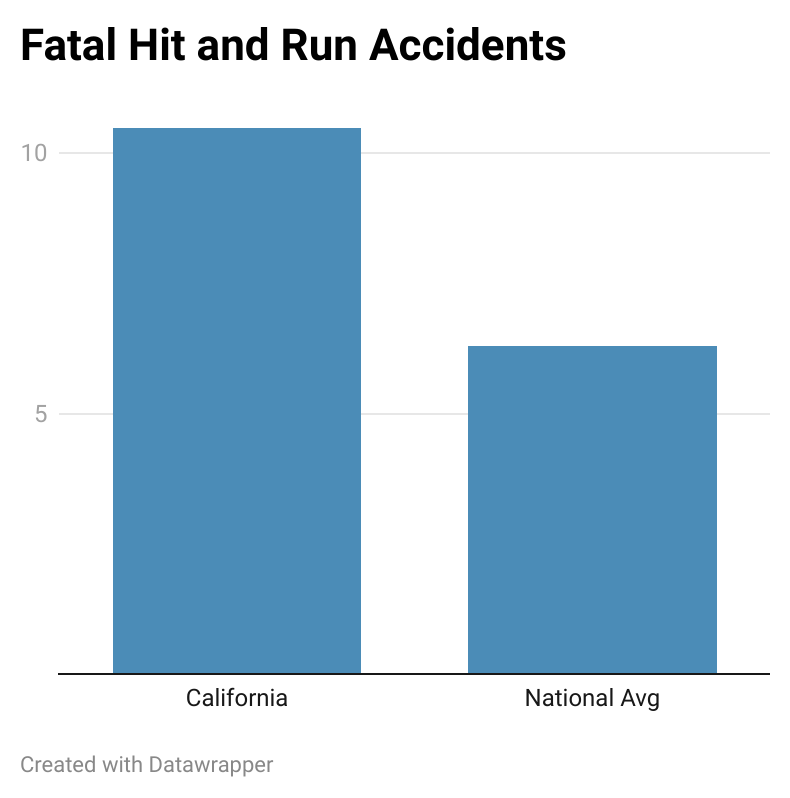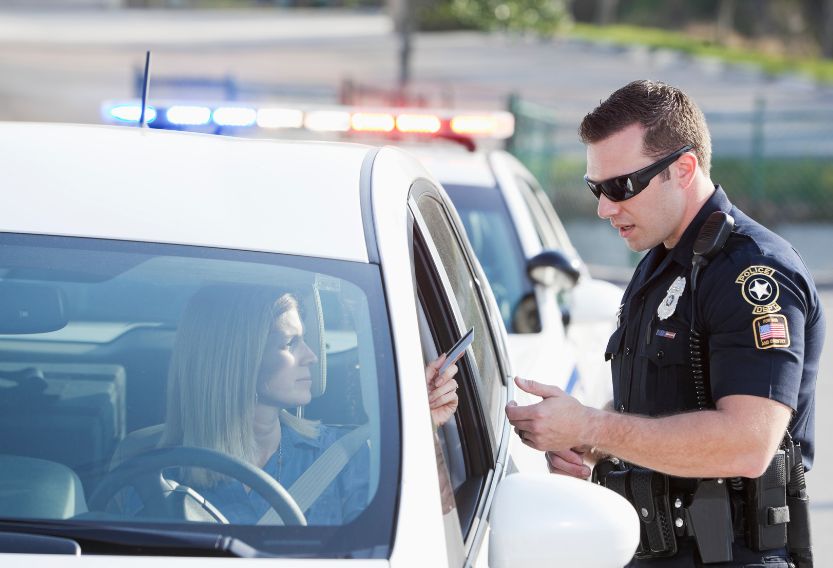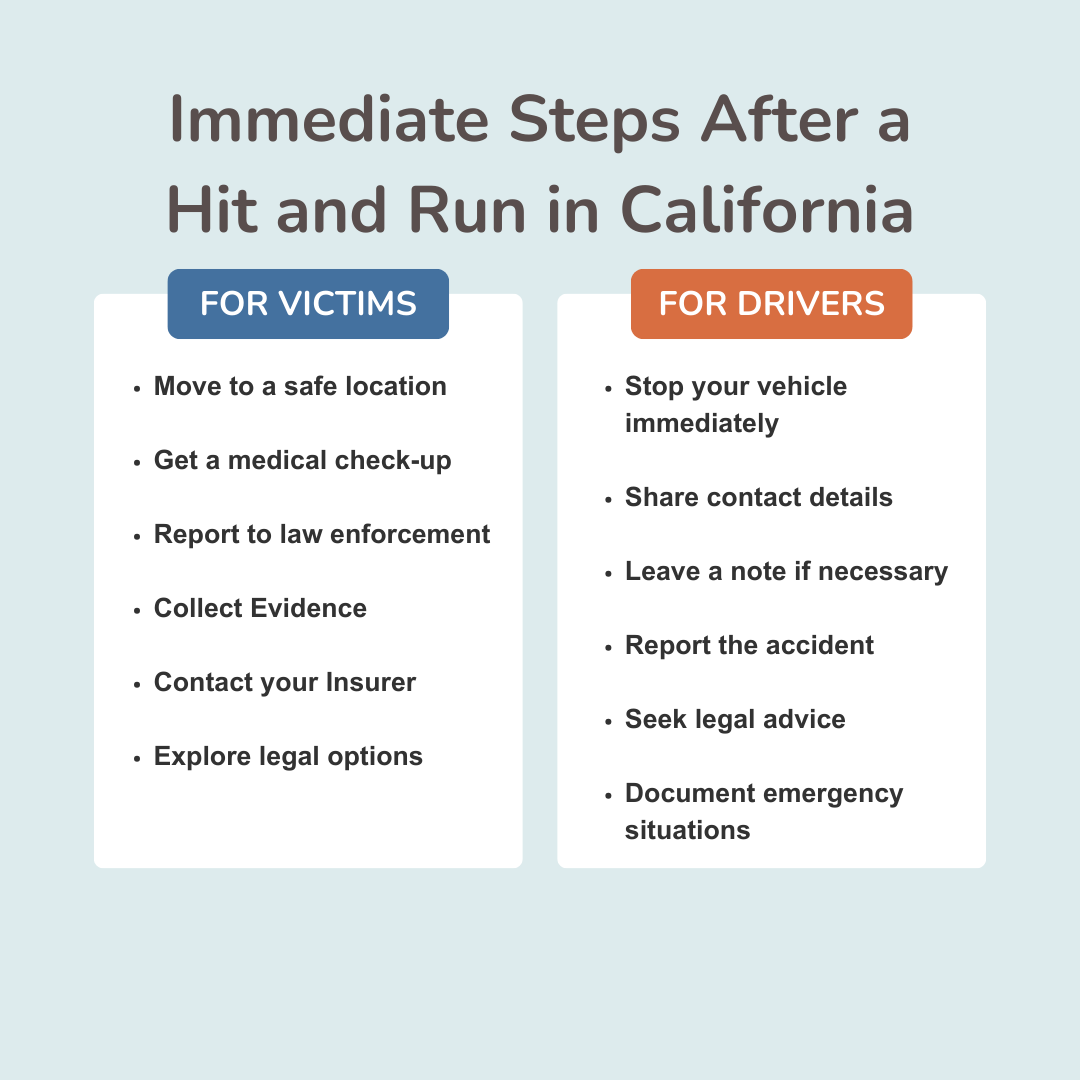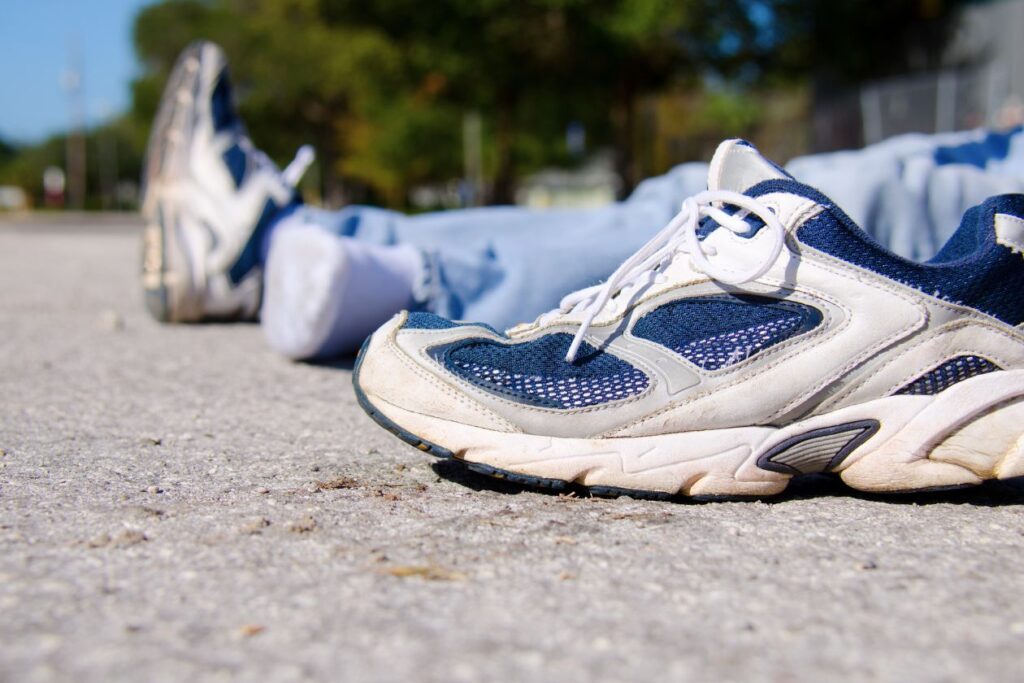Recent data from the California Office of Traffic Safety highlights a 12% increase in hit-and-run incidents involving pedestrians in 2022.
According to in-depth research conducted by the Suzuki Law Offices, over 1 in 10 fatal Golden State crashes are hit-and-run. Comparatively, the hit-and-run crash rate in the state is approximately 10.48 percent, which is significantly higher than the national rate of 6.3 percent.


This stark reality highlights the need for a comprehensive understanding of the California hit-and-run laws. As residents, commuters, and visitors in this dynamic state, it’s essential to know your rights and the legal landscape that surrounds these distressing incidents. This guide seeks to clarify the legal intricacies and offer straightforward, practical information.
- Definition of “Hit and Run” Under The California Vehicle Code § 2002
- Types of Hit and Run Laws
- What Is the Penalty for Hit and Run in California?
- California Hit and Run Laws and Related Offenses
- Immediate Steps to Take After a Hit and Run in California
- Find Expert Legal Support With The Personal Injury Center
Definition of “Hit and Run” Under The California Vehicle Code § 2002
The California Vehicle Code § 20002 outlines a “hit and run” offense as leaving the scene of an accident without first identifying oneself to the other party involved, especially when there’s property damage. This law doesn’t just apply to collisions with other vehicles but extends to any property damage, including hitting a fence, a mailbox, or even a pet.
Types of Hit and Run Laws
California hit-and-run laws are categorized into two main types: misdemeanors and felonies.
The difference is based on the nature of the accident – specifically, whether it involved property damage or personal injury/death.
1. Misdemeanor Hit and Run
Under California Vehicle Code 20002 VC, a misdemeanor hit and run is defined as follows:
“Any driver of a vehicle involved in an accident resulting only in damage to any property or vehicle shall stop at the nearest location that won’t impede traffic or jeopardize the safety of other motorists.”
This law addresses situations where the accident causes property damage but no physical injuries. In such situations, the driver must locate a safe area to stop that doesn’t disrupt other traffic.
Once stopped, the driver is legally obliged to assess the damage. The law requires that you make a reasonable effort to find the owner of the damaged property. If the owner is not present, then leaving a note with your contact details and a brief explanation is the next best step.
It’s also essential to understand that failing to follow these steps can lead to significant legal repercussions. While it might be a misdemeanor, consequences can include fines, potential jail time, and a mark on your driving record.
2. Felony Hit and Run
More severe is the felony hit and run, as described in California Vehicle Code 20001 VC:
“Any driver of a vehicle involved in an accident that results in injury or death to another person shall immediately stop the vehicle at the scene of the accident and shall fulfill their legal requirements described in Vehicle Code Sections 20003 and 20004.“
This law is triggered when an accident results in injury or death. Here, the driver’s responsibilities extend beyond just stopping and exchanging information. They must also provide reasonable assistance to the injured party. This might mean calling 911 if someone is hurt or ensuring an injured person can get to a hospital if needed. The idea is to ensure that those harmed receive immediate care.
Neglecting these duties in a felony hit-and-run can result in severe legal consequences, including significant jail time, hefty fines, and long-term impacts on your personal and professional life. It’s a scenario where ethical and legal obligations align – ensuring the safety and well-being of all involved is paramount.
If you’ve suffered an injury or are dealing with a hit-and-run case and require legal assistance, The Personal Injury Center is here to connect you with the best legal experts in your area. We believe that the right support can make all the difference in ensuring justice and fair treatment in such challenging situations.
What Is the Penalty for Hit and Run in California?
In California, hit-and-run offenses carry severe penalties, emphasizing the state’s stringent stance on road safety. Convictions can lead to fines between $1,000 to $10,000, varying with the incident’s gravity—property damage or personal injury.
The legal system’s approach, distinguishing between misdemeanors and felonies, aims to ensure accountability and uphold justice for victims, reflecting the seriousness of these crimes.
Misdemeanor Hit and Run Penalties
For incidents involving only property damage, being convicted of a misdemeanor hit and run under California Vehicle Code 20002 can lead to:
- Up to six months in jail
- A fine of up to $1,000
- Probation for up to three years
- Restitution payments to cover the damage caused
- Two points added to your California driving record
Specific circumstances, including your criminal history, could still lead to a requirement for community service. It’s important to note a significant change in legal proceedings for misdemeanor hit-and-run cases. Following a California Appellate Court ruling in 2019, individuals charged with a misdemeanor hit and run under California Vehicle Code 20002 VC are no longer eligible for resolution through a civil compromise.


Felony Hit and Run Penalties
If the hit and run resulted in serious injury or death, and the person is convicted of a felony under California Vehicle Code 20002, the consequences are significantly harsher:
- A minimum of 90 days in county jail, with the potential for up to four years in California state prison
- Fines ranging from $1,000 to $10,000
- Mandatory restitution to the victims
These penalties underscore the state’s commitment to ensuring justice for the victims of hit-and-run incidents, emphasizing the importance of stopping and fulfilling your legal obligations at the scene of an accident.
California Hit and Run Laws and Related Offenses
Navigating the aftermath of a hit and run in California can introduce a maze of legal repercussions beyond the initial penalties. The implications of such incidents are far-reaching, influencing not only the immediate charges but also connecting with other legal offenses, potentially complicating the legal situation for those involved.
For example, if someone, in a moment of panic following a minor collision, decides to flee the scene, they might not only face hit-and-run charges but could worsen their situation if they were driving without a valid license or their license was suspended.
Related Offenses and Their Impact:
- Vehicular Manslaughter (Penal Code 192c): In instances where a hit and run results in a fatality, the driver could face vehicular manslaughter charges. It can be classified by carelessness levels: “standard” (lack of ordinary caution) or “severe” (extreme recklessness). Penalties range from one year in county jail to six years in state prison, depending on the case’s seriousness, the driver’s past, and any substance use involved.
- Driving with a Suspended License (Vehicle Code 14601.1(a)): Should the individual involved in the hit and run be found to have been driving on a suspended or revoked license, this offense adds another layer of legal trouble, carrying fines and possible jail time.
- Driving without a License (Vehicle Code 12500(a)): Operating a vehicle without a valid license during a hit-and-run complicates the case further. Depending on how the offense is charged—misdemeanor or infraction (a minor violation) —the person could face additional penalties, including jail time.
- Exhibition of Speed (Vehicle Code 23109(c)): If the hit-and-run incident stemmed from reckless driving behaviors such as speeding or street racing, the charges could be compounded with an exhibition of speed offense, escalating the severity of the legal consequences.
Immediate Steps to Take After a Hit and Run in California
The moments following a hit-and-run can be chaotic and stressful, whether you’re the victim or the driver. Knowing the right steps to take can significantly impact the pursuit of justice and compensation for victims, as well as the legal defenses and obligations for drivers.


For Victims: Navigating Rights, Justice, and Compensation After a Hit and Run
Becoming a victim of a hit-and-run can be a traumatic and unsettling experience, leaving you to navigate through a maze of legal and emotional challenges. Understanding your rights and the steps to take immediately after such an incident is paramount to ensuring your safety, securing justice, and obtaining rightful compensation.
Prioritize Your Safety and Health
- Ensure Safety First: Immediately move to a secure location away from traffic. Your safety is the top priority.
- Seek Medical Attention: Even if you believe you’re unharmed, some injuries, like internal trauma or concussions, may not show symptoms immediately. Prompt medical evaluation is crucial.
Legal Steps and Gathering Evidence
- Report the Incident: Contact the police without delay. A detailed police report is essential for legal and insurance claims.
- Gather Evidence: If possible, collect evidence at the scene. Photographs of the scene, your injuries, the car number plate, and any property damage can be invaluable. If there were witnesses, try to get their contact information.
- Contact Your Insurance Company: Inform your insurer about the accident promptly, as understanding your coverage is crucial for navigating compensation claims under California hit-and-run insurance laws.
In California, as a victim, you have the right to pursue a personal injury lawsuit against the at-fault driver, a critical avenue for justice regardless of the offender’s decision to flee the scene.
In times of worry and uncertainty, The Personal Injury Center can connect you with the best legal expertise to navigate this process, ensuring you receive the right support and guidance.
For Drivers: Understanding Legal Defenses and Obligations in Hit-and-Run Cases
Being involved in a hit-and-run might subject you to several legal complications. However, a clear grasp of your responsibilities and the defenses available to you can significantly mitigate these complexities. Here’s how to manage this uncertain situation with care and legal expertise:
Fulfilling Your Legal Obligations
- Stop Immediately: According to California and run laws, if you are engaged in an accident, you must stop immediately. It is a mandate, regardless of wrongdoing. Departing from the scene contributes to your legal problems and could result in harsh penalties.
- Exchange Information: Sharing your contact and insurance details with the other party forms the cornerstone of your legal obligations post-accident. If the other party is not present, it is your responsibility to leave a note in a visible location stating your information and the occurrence.
- Report the Incident: Transparency with law enforcement is crucial, especially if the accident involves injuries or substantial property damage. Timely reporting not only aligns with legal mandates but also aids in the accurate documentation of the event, which is vital for both insurance and legal proceedings.
Navigating Potential Defenses
- Lack of Knowledge: One possible justification is that you had no idea an accident had occurred. This could apply if the touch was so minor that you were unaware of the damage or had reason to assume there was no harm done.
- Misunderstanding the Law’s Requirements: Another defense could be a misunderstanding of what the law expects of you in the aftermath of an accident. Legal intricacies can complicate seemingly easy obligations, making the assistance of an experienced attorney vital.
- Emergencies: Situations where stopping immediately might pose a significant risk to your safety or obstruct emergency services can also form the basis of a defense. The law accounts for such exigencies, recognizing that the immediate priority is safety.
Navigating the aftermath of a hit-and-run demands more than just a basic understanding of your obligations—it requires strategic legal insight. Consulting with a lawyer is essential in understanding your rights, obligations, and the intricacies of defenses available to you. An experienced attorney can dissect the details of your case, advising on the best course of action and potentially identifying defenses you hadn’t considered.
Key Takeaways
|
Find Expert Legal Support With The Personal Injury Center
If you’re dealing with the aftermath of a hit and run, The Personal Injury Center is here to bridge the gap between you and the legal assistance you need.
Our mission is to educate and empower you, ensuring you understand your rights and the compensation you’re entitled to. Contact us to be connected with a specialized lawyer in your region who is best suited to handle your case. Let us help you take the first step toward justice and recovery!



